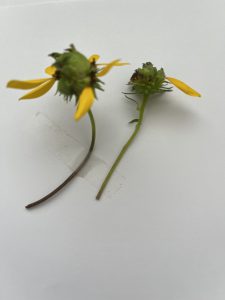By Rebekah Heppner, Pinellas County Master Gardener Volunteer
I was very excited when my starry rosinweed (Silphium integrifolium) came back after looking dead all winter. Then it bloomed. Or at least it tried to. Where the flower should be It grew a very weird-shaped ball with a few petals sticking out at odd angles. I thought it was just some random occurrence until another and another came out that way. I know I should have cut one and taken it to the help desk to find out what was going on, but I was too appalled. It looked like aliens had attacked the plant. I cut them off and put them immediately in the trash. Then I saw similar growths on a dune sunflower (Helianthus debilis) growing nearby. A brand-new dune sunflower I planted in an area of my garden that is hard to please because I thought, well, dune sunflower will work, it’s tough. Right?


So, I tried Googling “strange bud formation on wildflowers in Florida” and various other combinations. Nothing. I only had a vague understanding of galls; they mostly affect oak trees and I have none, so I’ve never bothered to learn about them. But at some point, it had occurred to me that these weird growths could be something like galls. Before I had a chance for further Googling, I was on the UF/IFAS Pinellas County YouTube page for a completely unrelated reason and stumbled upon a video titled “Exploring the Biology, Chemistry and History of Insect Galls.” This is a very interesting presentation from July 2021 by Christine Leonard who wrote her thesis on galls and is clearly very excited about them. It’s mostly about oak tree galls but, forty-eight minutes in, while responding to a question about a photo she says something like “that is swollen tissue on a flower bud of a Goldenrod caused by a midge gall.” Now we were getting somewhere. Ms. Leonard concludes her presentation saying that galls don’t harm the oak trees and help the insects that make them, so we should not be worried about them. Historically, humans have even used galls for their own purposes (she presents a recipe to make ink!). All good, right?
Not for me. I don’t grow wildflowers for “midges,” despite their very cute name. I grow them for butterflies and bees. I went back to Google and searched for info on midge galls. This eventually led me to a few articles about galls in general including this one from the University of Minnesota Extension that mentions “Bud or flower galls” and “Gall midges.” The consensus seems to be that the best “treatment” is to remove the galls and put them in the trash. Another suggestion is to “select gall free plants” and one article proposed using a horticultural oil on the plants while the midges are actively laying their eggs in the new buds. That might work, but who has the time to watch buds forming and wait to see if midges (which are teeny-tiny flies) are hanging around them? Not me. And certainly not in spring when there is so much else to do in my garden. Once the gall has formed, it seems, it is made up of tissue (insect food) that is too thick for anything to stop its growth.
I’ve already followed the advice to cut the galls off and put them in the trash (do not compost!). Since this is a phenomenon of spring, maybe the worst is over? I certainly hope so. I’m still appalled as I see my beautiful pollinator plants bloomless, but I certainly know something about galls now. For those who want to learn even more there is a book “Insect Galls of Florida” available in the IFAS bookstore that discusses our state’s 200 gall species. Appalled yet?
 2
2
